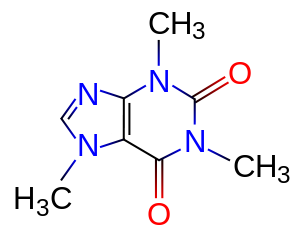| Chemical structure of Caffeine. (Photo credit: Wikipedia) |
A cup of coffee, a soda or a piece of chocolate…
How much caffeine do you consume each day? Do you even know? If you have health problems and you have been cautioned to avoid caffeine altogether or to limit your caffeine intake, then you are cognizant of the amount of caffeine you consume or you make it a point to read food and drink labels in order to limit your intake. On the surface, food/beverage labels allow us to practice a type of “informed consent.” But what happens if the labels are incomplete, that is, what if the label does not list all the ingredients and/or the amount of each ingredient?
Caffeine Toxicity
You read correctly “caffeine toxicity.” The scientific definition of toxicity is the degree to which a substance can damage an organism. Of course, the toxicology effect of any substance is dose-dependent. In other words, any substance can be considered a poison when over-consumed in a specific period of time. Even water! And yes, it is true for caffeine.
Energy drinks and caffeine
Energy drinks have been around for a while. Red Bull first came on the market in certain countries as early as 1987; however, over the past 10 years many more “caffeine rich” energy drinks have been introduced with clever names like Monster, Rockstar, and Full Throttle. It may surprise you to know that the Food and Drug Administration (FDA) does regulate the amount of caffeine in soda, but not energy drinks as they have been classified as a dietary supplement, as opposed to being considered a food item. In the case of Monster, two 24 ounce cans have as much caffeine as 14 cans of Coca-Cola.
Shining a spotlight on energy drinks
This week it was announced the the FDA is investigating reports of five deaths and one survived heart attack following the consumption of energy drinks. However, there have been previous words of caution issued by the American Academy of Pediatrics in a 2010 article, in which they concluded:
Energy drinks have no therapeutic benefit, and many ingredients are
understudied and not regulated. The known and unknown pharmacology of agents included in such drinks,combined with reports of toxicity, raises concern for potentially serious adverse effects in association with energy drink use. In the short-term, pediatricians need to be aware of the possible
effects of energy drinks in vulnerable populations and screen for consumption to educate families. Long-term research should aim to understand the effects in at-risk populations. Toxicity surveillance should be improved, and regulations of energy
drink sales and consumption should be based on appropriate research.
Additionally, the Substance Abuse and Mental Health Services Administration (SAMHSA) reports that emergency room visits connected to energy drinks have been rising. Research indicates that the number of emergency room visits that involved energy drinks jumped from 1,128 visits in 2005 to 16,053 in 2008 and 13,144 in 2009.
At-risk populations includes those children, teenagers and adults who have an underlying condition (diagnosed or not), that can be unknowingly aggravated by consuming energy drinks.
Meet the parents of Anais Fournier
Anais Fournier went to a mall in December 2011. She went to a candy store and purchased a 24 ounce can of Monster Energy. The next day she was back at the mall and bought another can. A few hours after drinking the second can Anais went into cardiac arrest and became unconscious. Anais died on December 23, 2011, she was 14. Cause of death: cardiac arrhythmia due to caffeine toxicity. It should be noted Anais was considered to be in an at-risk population as she had a fairly common heart condition “mitral valve prolapse” (1 in 20 Americans are affected by this condition). The two cans of Monster Energy contain 480 milligrams of caffeine.
Now Anais Fournier’s parents are suing the company that makes Monster Energy Drinks. Here you can view an NBC News’ Chris Clackum’s report on this case.
If you are having trouble viewing the video, you can see it here.
Some final thoughts…
People often find ways to stay alert, to start their day. Maybe they were up too late, maybe they abuse other substances like alcohol and drugs, maybe they just get into the habit of grabbing an energy drink on their way to work. After all, the cans are colorful and all their friends are drinking energy drinks. But so often, people don’t take the time to read a label. And it is very hard to stay informed if labels are incomplete. Perhaps many people don’t even realize that they are at-risk due to some undiagnosed medical condition.
It will be interesting to see how this case evolves. We do know this much: Anais is gone forever, but maybe her death will not be in vain if the FDA eventually determines that all energy drinks (dietary supplements) should include a detailed label listing all ingredients and the amount per serving.
Too much of any substance can be deadly.
Related articles








